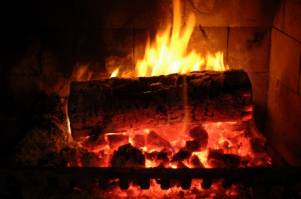|
Fireplaces
I’ll have to say this straight out – I love fireplaces. They are a great source of pleasure as well as heat. Here, we’re talking about them as part of an alternative energy program. As I mentioned on the page Wood Burning, fireplaces aren’t necessarily the most efficient way to burn wood for heat. I do think they are the most attractive and inviting. Properly done, wood burning can make a lot of sense as a supplemental source of heat. Improperly done, it wastes money and pollutes the air. What's Wrong With Traditional Designs?As much as I love fireplaces, I don’t think anyone should install a traditional one in their home. They are absolute money wasters. Old design was just a brick firebox to burn the wood with a chimney to exhaust the smoke. It heated the room by radiating heat into it. But most of the heat went up the chimney with the smoke. The fire draws air from the room to burn. If the room is other wise unheated, it does gain some heat from the fire. But if the fireplace is in a home with central heating where the main heating supply is keeping the house warm, the heated air drawn from the room up the chimney causes an actual net loss of heat from the home. That is, the radiant heat from the fire doesn’t make up for the loss of warm air heated by the central furnace up the chimney. I still hear some people claim that a Rumford design is efficient. As I explain on the Rumford page , it’s not. How Modern Fireplaces Do It BetterModern design allows fireplaces to be much more efficient. One way more heat is extracted from the fire is have a double-walled fire box. The fire burns in the inner firebox. There is an air space between the inner and outer walls and room air circulates through this space. It’s heated as the fire burns and is returned to the room. Ceramic glass doors across the front prevent room air from being drawn to the fire. Ceramic glass costs more than tempered glass, but has the advantage of being more transparent to radiant heat than tempered glass. This allows more heat from the fire to pass into the room Including a source of outside air to feed the fire and having secondary combustion chambers also improve efficiency.
Zero-Clearance FireplacesThese modern designs can be constructed of masonry, but it’s easier and sometimes more reliable to buy a prefab unit or what is called a zero-clearance fireplace. Zero-clearance units are called that because they can be placed in close proximity to flammable material without creating a fire hazard. Rather than a masonry chimney they use the same type of stovepipe exhaust that a wood burning stove uses. Fireplace InsertsIf you have an existing old fashioned fireplace, I recommend that you have an insert made. An insert is basically a wood burning stove that fits into the existing fireplace opening rather than being freestanding in the room. We did this in our home. The original fireplace didn’t even have a damper in it. Our home was poorly insulated and leaked a lot of air as well. We enjoyed the look, but I wince when I imagine how much energy we wasted with it. When we remodeled our house, we improved the insulation a lot and had an insert made for the fireplace. The insert has worked out great. It is doubled walled so it has the advantage of heating by convection. When we want to watch the fire, we leave the doors open. We shut the doors when we go to bed and it works as a wood-burning stove to add some heat to the house and keeps the furnace from kicking in. We have pretty cold winters around here. I know several people who heat entirely with wood, but that’s not for me. I enjoy the convenience of central heat and prefer to use wood as a supplemental heat source to reduce our use of fossil fuel to heat our home. You may want to do the same. LinksClick here to return to Alternative Energy Primer Home from fireplaces |
